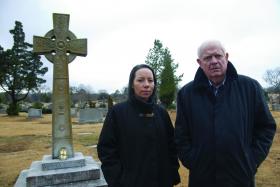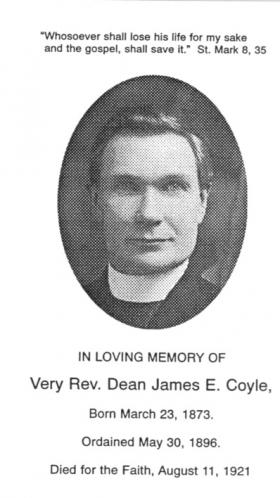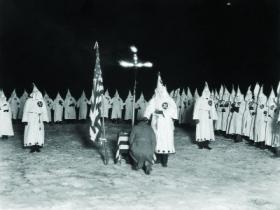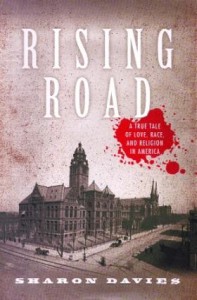Tv eye
Published in 20th-century / Contemporary History, Issue 3 (May/June 2010), Reviews, Volume 18Would you believe?
The murder of Fr James Coyle in Birmingham, Alabama, 1921
21 March 2010, RTÉ 1
Rising Road: A true tale of love, race, and religion in America
(Oxford University Press, New York, $27.95)
ISBN 9780195379792
by John Gibney

Presenter Brendan Shine with the author of Rising Road, Sharon Davies, at the grave of his grand-uncle, Fr James Coyle , in Birmingham, Alabama. (RTÉ)
The Catholic priest James Coyle was born in Drum, Co. Roscommon, in 1873 and was shot dead in Birmingham, Alabama, in 1921. For this episode of RTÉ’s Would you believe? Coyle’s grandnephew, the country-and-western singer Brendan Shine, sought to tell the story behind his ancestor’s murder. This is also the subject of Rising Road, a recent book by Sharon Davies, professor of law at Ohio State University, who was a prominent and effective contributor to the documentary. Both the programme and the book reveal a curious story, and between them pose a few questions about how one might best attempt to tell it.
On 11 August 1921, at very short notice, Fr Coyle had presided over a mixed marriage between the eighteen-year-old Ruth Stephenson, a native of Birmingham, and Pedro Gussman, a 42-year-old Puerto Rican immigrant. There may have been an element of convenience to this, for there were complicating factors. Ruth Stephenson was the only child of Edwin Stephenson, a ferociously anti-Catholic Methodist preacher who, ironically enough, specialised in impromptu marriages. But she had recently converted to Catholicism, and marriage may have been a way of escaping from her father’s control (Stephenson had seriously contemplated having his daughter committed to an asylum after her conversion). His response to her marriage was unequivocal: on the evening of 11 August, Revd Stephenson went to the local rectory and shot Fr James Coyle on its porch. He died later that evening.

Fr James Coyle
These events were virtually unknown in Brendan Shine’s family. Fr Coyle had a sister, Marcella, who had also lived in Birmingham and who later returned to Ireland. On the other hand, Coyle’s mother, who died in 1924, was never informed of her son’s death. Coyle would later be nominated for martyrdom in the 1940s, which technically made sense. For while the struggle for civil rights during the 1960s saw Birmingham, Alabama, become an enduring symbol of racism, in earlier decades it had been a hotbed of another prejudice deeply rooted in American culture: anti-Catholicism.
The rapid growth of Birmingham (‘the magic city’) between the 1870s and the 1920s stemmed from the vast deposits of coal, limestone and iron ore in its vicinity. As a growing industrial town it needed labour, much of which came in the form of European immigrants whose arrival in the Deep South provoked a resurgence of American nativism. And the fact that many of these immigrants were Catholics, such as the Irish, tapped into an old and deep vein of WASP anti-popery. The growth of organisations such as the American Legion and the revived Ku Klux Klan was also prompted by the tensions that accompanied US involvement in the First World War. In a fevered climate in which the worst stereotypes about Catholics were accepted without reservation, it was perfectly plausible for many to believe that the sinister design of ‘Romanism’ was ultimately to enslave America, and that its adherents were the foot-soldiers, never to be trusted. The strength of this unusually overlooked prejudice adds a very different dimension to the killing of Fr Coyle, and to the eventual trial of his killer.
The backdrop to the case is detailed in Sharon Davies’s Rising Road, which, perhaps unsurprisingly, focuses on the eventual trial of Revd Stephenson. But in order to get to that point, prospective readers must put up with a lot; much of the first half of Rising Road is turgid and overwritten, being weighed down with an overabundance of often irrelevant detail and a disconcerting level of speculative commentary about how its protaganists ‘must’ or ‘may’ have felt. It is a pity; had Davies restrained a tendency towards purple prose and been subjected to more rigorous editing, her ability to tell a story clearly, and with a shrewd eye for telling detail, could have resulted in a tighter and better book.

Ku Klux Klan initiation ceremony, 1920s—Coyle openly denounced it as ‘un-American’, and became a figure of hate. (Jack Benton—Hulton Archive/Getty Images)
There are also striking omissions. It would have been useful to learn about the heritage of American anti-Catholicism, and, remarkably, there is no account of the Catholic immigrant communities whose presence stoked the bigotry that underpinned Coyle’s murder. After all, in April 1920 a visit to Birmingham by Éamon de Valera (ignored by Davies but previously described in HI 12.4, Winter 2004) had provoked huge opposition: even aside fro anti-Catholicism, support for ‘Sinn Féinism’ in America could be painted as treasonous. Yet such hostility galvanised an equally vigorous response in support of de Valera’s visit, spearheaded by none other than Fr James Coyle. In many ways, Would you believe? had a greater resonance to an Irish audience; its measured and thoughtful tone was anchored by the simplicity of the human story it told, and Shine himself proved an engaging presenter (complete with the inevitable gig). But the story is not just relevant to an Irish audience; Fr Coyle, after all, is still remembered in the Civil Rights Museum in Birmingham. It is the potential appeal of this story to a broader audience that leads one back to a book intended to reach out for it.
Rising Road improves greatly once it reaches the great set-piece of Revd Stephenson’s trial. It was something of a contemporary cause célèbre (one contributor to Would you believe? went so far as to compare it to that of O.J. Simpson). As early as 1904 Fr Coyle had been cautiously speaking out against segregation. But he did not shy away from confrontation, and as the Klan came to prominence once again Coyle openly denounced it as ‘un-American’ and became a figure of hate. Perhaps unsurprisingly, Edwin Stephenson’s defence (spearheaded by Hugo Black, a future member of the US supreme court) was discreetly funded by the Klan. After much adroit insinuation—that Ruth had been deliberately seduced from her faith, and that Coyle had in fact married her to a ‘negro’—Stephenson, who had actually admitted to shooting Fr Coyle, was unanimously acquitted by an all-white jury. And one suspects that had Stephenson been acquitted of murdering a black man, that would hardly be deemed remarkable enough to warrant either a documentary or a book.
 The somewhat overwrought tone of the book is in stark contrast to the effective simplicity of the documentary. Despite its flaws, Rising Road is worth reading, and this episode of Would you believe? set down a worthy marker for the rest of the series. For those inclined to take a moral from the tale, irrespective of how it is told, the bigotry and racism that characterised the murder of James Coyle and the acquittal of his murderer are sufficiently unsavoury to speak for themselves. HI
The somewhat overwrought tone of the book is in stark contrast to the effective simplicity of the documentary. Despite its flaws, Rising Road is worth reading, and this episode of Would you believe? set down a worthy marker for the rest of the series. For those inclined to take a moral from the tale, irrespective of how it is told, the bigotry and racism that characterised the murder of James Coyle and the acquittal of his murderer are sufficiently unsavoury to speak for themselves. HI
















